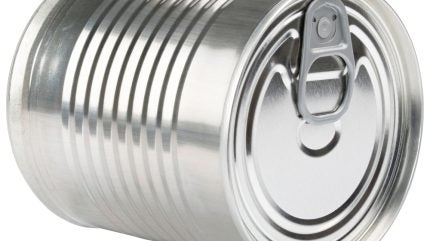
Metal cans look simple. Making them isn’t. Canmaking blends metallurgy, high-speed forming, precision printing and food-contact compliance—tuned for cost, safety and circularity.
Here’s a plain-English tour for packaging professionals everywhere.

Discover B2B Marketing That Performs
Combine business intelligence and editorial excellence to reach engaged professionals across 36 leading media platforms.
The two big families: two-piece and three-piece
Two-piece (DWI/DRD): Dominant in beverages and increasingly used for foods and aerosols. A press blanks cups from coil, bodymakers draw and wall-iron (or deep-draw and redraw) to height, then dome the base.
After trimming, the body is washed, decorated, varnished, necked and flanged. Ends (lids) are made separately and double-seamed at the filler.
Three-piece: A rectangular sheet is formed into a cylinder and welded. The side seam is protected with lacquer, bodies may be beaded for strength, then flanged for ends.
This route excels in format flexibility—diameters, heights, and speciality shapes—and tolerates long retort cycles.

US Tariffs are shifting - will you react or anticipate?
Don’t let policy changes catch you off guard. Stay proactive with real-time data and expert analysis.
By GlobalDataMaterials that do the heavy lifting
Can bodies and ends use aluminium and packaging steels (tinplate or ECCS). Temper, gauge and coating weights are specified tightly to balance formability with buckle resistance and opening performance.
Substrate choice is influenced by product, process (retort, pasteurisation, carbonation), regional availability, and total cost of ownership—energy, scrap value, logistics and extended producer responsibility (EPR) fees.
Coatings and compliance
Interior linings protect product and metal through sterilisation or pasteurisation and storage; exterior systems deliver print quality, abrasion resistance and line slip.
Around the world, brand owners and canmakers are moving to BPA-non-intent systems and reassessing PFAS use, with rules and transition timelines differing by region.
Whatever the jurisdiction—EU, US, China, Japan, the GCC, Latin America—expect more rigorous migration testing, stricter positive/negative lists, and closer supplier audits.
Qualification now typically includes full-pack trials, accelerated ageing, sensory, seam compound compatibility, and filler clean-down studies.
Design details that matter on the line
- Ends and apertures: Stay-on-tab beverage ends, easy-open food ends and peelable foil systems each trade off opening force, venting behaviour, retort endurance and cost.
- Double seams: Body/cover hook geometry, countersink depth and compound application define seam integrity. Invest in teardown capability, vision systems and disciplined seam set-up.
- Light-weighting and necking: Multi-stage necking reduces metal in ends but tightens tolerances, especially under high CO₂ or hot-fill. Monitor buckle and drop performance statistically, not anecdotally.
- Print & varnish: Dry-offset or litho needs the right slip, cure and scuff resistance for pasteurisers, conveyors, accumulation tables and retail handling.
Sustainability without the slogans
Metal cans are among the most successfully recycled consumer packages, but collection systems vary widely—deposit return in some markets, kerbside or bring-banks in others. Two implications for global teams:
- Design for reality, not theory: Specify coatings and inks compatible with dominant regional recycling routes; avoid labels and fitments that disrupt detection or smelting.
- Mind the mass balance: Aluminium often returns to can sheet; steel packaging typically returns to steelmaking. Both deliver strong “real recycling” outcomes, but reported rates and methodologies differ by country—so align claims with local rules.
Operations and supply chain—what to watch
- Metals and energy volatility: Sheet allocation, conversion capacity, rolling mill outages and energy pricing can swing costs and lead times quarter-to-quarter. Dual-qualify substrates, ends and plants where volume justifies it.
- Water and cleaning: Modern washers target low conductivity, low carry-over and heat recovery. Water risk varies by geography; design chemical programmes and rinse stages accordingly.
- Data at speed: High-speed lines need real-time analytics—seam vision, buckle/pressure monitoring, decoration inspection—to maintain capability as gauges fall.
- Regulatory drift: Expect continued movement on food-contact rules, recycled content targets, and EPR fees. Build a living compliance dossier per SKU and market.
The bottom line
Canmaking rewards detail. If you manage packaging globally, your leverage is in specifications, coating compliance, seamer capability, and end-of-life performance—not broad claims.
The leaders create robust, region-ready specs, qualify changes with data, and stay close to both mills and fillers.
Want to go deeper?
You might find The Canmaker magazine helpful. It is a monthly, business-only trade title for the global metal packaging industry, delivering news, features, reviews and commentary. Those interested in consistent, trade-focused coverage can start here.





